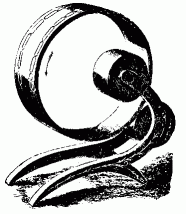REINVENTING THE SQUARE WHEEL
by Donald E. Simanek
Why build an unworkable device? Every basement tinkerer has probably built at least one device that didn't work as expected. One can learn a lot from such failures, for they teach us the pitfalls of design, the limitations of materials and the restrictions imposed by nature's laws. It's easy to superficially examine a drawing or blueprint of a device, and glibly say "That will never work." It's quite another thing to reason exactly why it doesn't work, and still deeper insight may be gained by hands-on manipulation of the recalcitrant mechanism.
Perpetual futility.
When people say "It'll never work," they may sometimes be right. Most new ideas turn out to be wrong, and are swept under the rug of history. But even wrong ideas can be useful, for they give us valuable information about what doesn't work, narrowing the field of things we might try that might work. Unfortunately some people never give up on a discredited idea. Such is the case with the perennial search for perpetual motion. Even today some "perpetual motionists" firmly believe it is possible, devoting considerable time and money to attempts to achieve it.
 |
| One of Bhaskara's wheels. |
|---|
Perpetually-turning wheels were described in Sanskrit treatises in the 5th century, and later by the Indian mathematician Bhaskara (c. 1159). One was a wheel with cylinders around its rim partly filled with mercury. As the wheel turned, the motion of mercury was supposed to keep the wheel heavier on one side of the axle, causing it to rotate perpetually. (If you build this model, use colored water. Mercury is an environmental hazard.)
This idea reappears in Arabic manuscripts, one of which contained six perpetual motion devices. These designs later reached Europe. A wheel described by French architect Villard de Honnecourt in 1245 is identical to a design from Arabia—an overbalanced wheel with hinged hammers or mallets equally spaced around its rim. Villard insisted on an odd number of hammers. He claimed his device would be useful for sawing wood and raising weights.
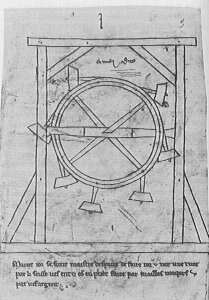 |
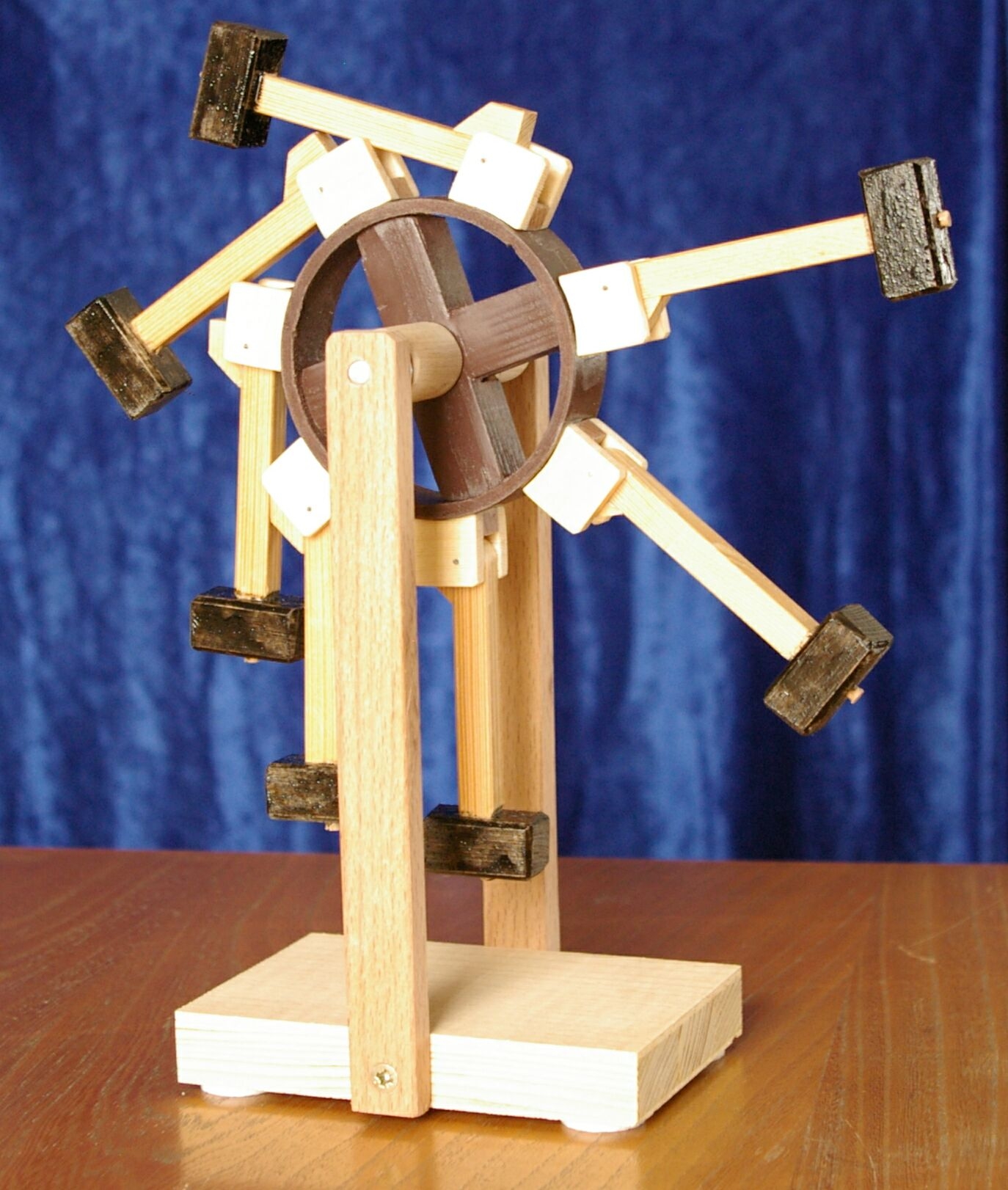 |
| Villard de Honnecourt's wheel. | Wooden model of Villard's wheel built by Hans-Peter Gramatke. |
|---|
.
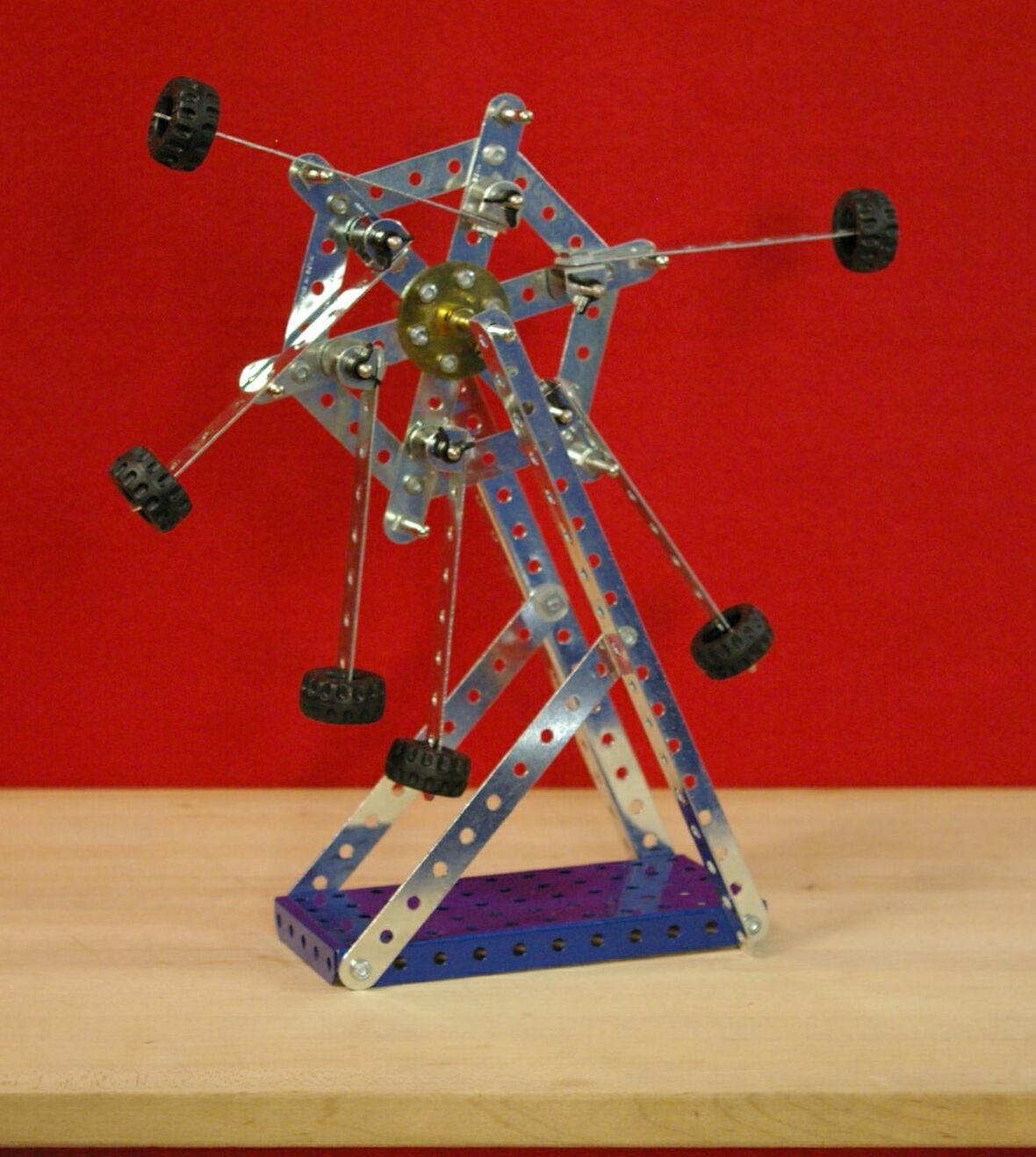 |
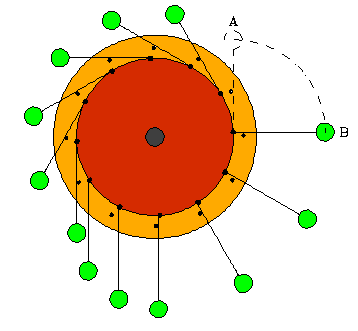 |
| Model of Villard's wheel. | The action of the flipping weight. |
|---|
One reason these overbalanced wheels seem plausible to some people is because a static picture is used to represent a dynamical situation. People suppose that the falling hammer gives the wheel an extra impetus. But when the wheel moves clockwise (perhaps by giving it a push), the weight falling from A to B pushes the wheel backward (counterclockwise) during its fall, which probably isn't what the inventor wanted. Casual inspection of the diagram would not lead one to expect this, but it's easily observed once you build one and try it. Of course some of the forward motion of the wheel is recovered when the weight arm hits the peg at position B, but there's a net loss because all materials are somewhat elastic, converting kinetic energy to thermal energy when compressed. The hammers' fall doesn't generate additional energy, but causes loss of energy. A simple flywheel without the hammers would work better.
Leonardo da Vinci (1452–1519) studied several versions of overbalanced wheels with moving weights, using a method that anticipated modern force and torque methods, and showed why they could not work.
Moreover, you might set yourself to prove that by equipping such a wheel with many balances, every part, however small, which turned over as the result of percussion would suddenly cause another balance to fall, and by this the wheel would stand in perpetual movement. But by this you would be deceiving yourself.... As the attachment of the heavy body is farther from the center of the wheel, the revolving movement of the wheel round its pivot will become more difficult, although the motive power may not vary.Leonardo's comment is especially perceptive. In modern terms it says that as a weight moves farther from the rotation axis, the gravitational torque on it is greater, but the moment of inertia of the wheel is simultaneously increased, making the gravitational torque less effective in increasing or sustaining motion of the wheel. The net gain from shifting weights is zero.
Leonardo compared perpetual motion seekers to alchemists who tried to make gold from base metals. "Oh, ye seekers after perpetual motion, how many vain chimeras have you pursued? Go and take your place with the seekers after gold".
All perpetual motion machine designs, when carefully examined, can be shown to be unworkable for at least two reasons. (1) Theoretical: They are based on incorrect assumptions about physics, or apply physics incorrectly. (2) Experimental: If you build and test them they don't work.
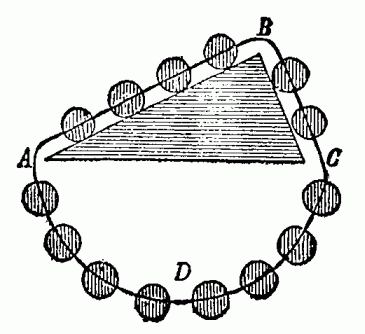 |
 |
| Simon Stevin's ball-ramp. | Model of Stevin's chain. |
|---|
Flemish mathematician and engineer Simon Stevin (or Stevinus) (1548-1629) analyzed a device consisting of a chain of balls on a frictionless double ramp. The chain was supposed to slide counterclockwise since there was more weight of chain to the left of the vertex. But Stevin's analysis showed that the system had no inclination to move at all, for it is always in static balance. The understanding Stevin gained from this analysis led him to formulate a fundamental principle of mechanics, known as "Stevin's principle of virtual work", which is found in textbooks even today.
Something about the seductive notion of perpetual motion tantalizes restless minds, who say, "Perhaps there's some principle of physics, as yet unknown, that we might discover if we just alter the design a bit." So, through the centuries, they tinkered with the designs, in a fantastic variety of ways, until the proposed machines became hopelessly complex. Such is the perversity of nature that none of them worked. Inventors should have taken the advice of Engineer Jacob Leupold (1674-1727) who observed (in his Theatrum Machinarum Generale, Leipsic, 1724):
The Perpetuum Mobile, or the machine that runs without external power without stopping, as long as material lasts and nothing breaks, moving itself, is so well known by name today that even minor craftsmen, even bootmakers and tailors, not only talk about it, but fancy they could make such a thing if they only had money and time. As this is something that many have searched for with great desire, time effort and cost, then surely it is perpetuum mobile. This desire is, even today, so deeply anchored in so many that they would rather let themselves be beaten to death than confess that they failed.The reason is that these people have no foundation in mechanics. Many do not know how to calculate motions, and therefore start construction based on imagination and haphazard experimentation.
 |
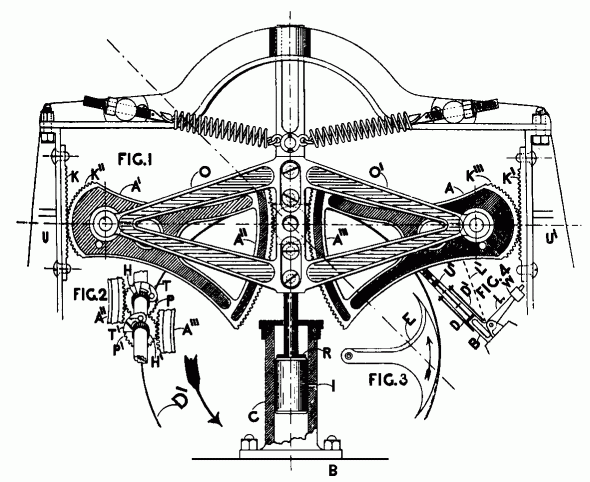 |
| Pierre Richard's Overbalanced chain (B), with brake (C). 1858. British patent No. 1870. |
Arthur E. Gilbert's perpetual motion, 1902, with a helpful arrow. |
|---|
Some inventors were so confident that they included a brake in their design to prevent the machine from turning so rapidly that it would tear itself apart. They needn't have worried.
Some drawings included an arrow showing which direction the inventor supposed that the wheel would turn. This is especially helpful, for without it we physicists wouldn't have the slightest idea which way the wheel should turn. If laws of physics allow the wheel to turn equally well in either direction, you can be quite sure the wheel won't initiate motion by itself, and won't sustain motion forever when you give it a push.
By the 19th century we see a refreshing return to simple basics. F. G. Woodward proposed a hoop wheel supported by two rollers. This is about as simple a design as you can imagine. Since the wheel always has more weight to the left of the rollers, that side should move down, as the arrow indicates. But the wheel stubbornly defies that "logic", refusing to budge.
|
Perpetual optimism.
Inventors before the 17th century had no physical laws of energy and momentum that would cause them to doubt the possibility of perpetual motion. But today we have a body of well-tested and accepted laws of mechanics that clearly tell us that certain things are impossible in nature, and no experimental evidence suggests otherwise. So how can anyone still expect to invent a perpetually moving mechanism? Well, many do, undeterred by a long history of total failure, contemptuous of the laws of physics, and oblivious to scientists who declare, "It'll never work."Hans-Peter Gramatke has identified 1800 perpetual motion patents in the USA, England, France, and Germany between 1860 and 2000, and a dozen patents from other countries. From 2000 on, an average of about 50 patents per year worldwide were issued. Most were in the four countries named above, although Japan, China and Korea show recent increase. These are patents that were "obviously" intended to be perpetual motion. There may be many more unworkable device patents in other categories.
Patent examiners do look for serious flaws in patent applications, but their primary criterion for patentability is that a device be a new idea; it doesn't need to be workable or practical. That's why unworkable devices get patented. Today, inventors avoid using words that would signal to an examiner that their device is supposed to get something for nothing, or that it is violating any well-established laws of nature.
Has all of this effort been a waste of time? Not entirely. Failed experiments give us a better understanding of the inherent limitations in nature's operations. Science learns from its mistakes. Perpetual motionists's mistakes get perpetually repeated.
Pixie dust.
Perpetual motionists are especially attracted to those parts of physics they don't understand. William Gilbert (1544-1603) summarized his experiments on magnetism in his book De Magnete (1600). The book was a sensation, widely read and widely misunderstood. It stimulated all sorts of incorrect pseudoscientific notions about magnets some of which still persist today. One fellow, heavily invested in a scam magnetic perpetual motion device, wrote to me that every physicist should know that magnets contain infinite stored energy. As an example he cited the lowly refrigerator magnet, which he said, "can hold itself in place forever, working against the pull of gravity, so it obviously has unlimited stored energy." Obvious to him, perhaps, but physicists know that work is the product of force and the distance that force moves something. A magnet does not move as it clings to the refrigerator, so it does no work and expends no energy.Since simple mechanisms have been so well studied for so long, perpetual motionists today concentrate on elaborate and complex schemes, then challenge skeptics to find the flaw. Science writer Bob Schadewald once observed, "A perpetual motionist typically concocts a scheme so complicated that he can't see why it won't work. He then assumes that it will work." Some perpetual motionists pin their hopes on cutting edge physical speculations of theoretical physics. Zero point energy and dark energy are popular now. Perpetual motionists use these as the stage magician uses "magic pixie dust"—to justify apparent miracles. Some postulate as-yet undiscovered laws or hidden energy sources in nature, give them names and then assume they have just those properties required for success of their perpetual motion machine. Finally, they forget that these exist only in their imaginations.
Zero point energy is a useful concept that has been experimentally confirmed in many ways. But this energy is "locked up" by constraining laws of physics that prevent it from producing useful work. There is not a shred of evidence, from experiment or established theory, that suggests any way to utilize zero point energy as the driving energy for a cyclic machine. Dark energy is still a speculative hypothesis whose usefulness in physics theory remains to be seen. It, too, seems to be unavailable for conversion to useful work.
Beyond the fringe.
In the long search for perpetual motion, we must mention the sad fact that some inventors misrepresent their product, and sometimes commit outright fraud.Over the years I've seen many claims of machines with efficiencies of 135%, 200% or even better. Have these marvelous machines alleviated the energy crisis yet? Inventors who make such claims usually don't know how to measure efficiency properly. A few are deliberately engaged in deception. The machines that appear to work best turn out to be deliberately fraudulent.
If such machines worked they would violate not only conservation of energy, but also conservation of momentum, and Newton's laws as well. Hardly any physics laws, that we have relied upon for centuries, would be left standing. If these laws were that badly flawed, you'd think someone would have noticed by now. The consequences would be staggering, not just for physics, but also for our daily lives. If these laws were operating differently than the textbooks say, we would be living in a quite different universe, one that we can only imagine. The universe we inhabit stubbornly refuses to allow such things to happen. That relieves of the difficult task of writing environmental impact statements for perpetual motion machines.
Physics laws are inter-related in a tight, logical structure. You can't pick ones you like and discard the rest.
How can we say that some things are impossible?
Of course, science has not yet discovered all of nature's secrets. In the future we are sure to formulate new principles of physics. Even some of the laws we now know to be valid may be found to need modification or reinterpretation as future discoveries are made. It is even possible that some basement inventor might stumble onto a useful device or even a new physical principle while trying to achieve perpetual motion.Should we fund research into perpetual motion? I think not. A thing is not necessarily true just because we'd like it to be. Nature has limitations. The reason why it would be foolish to pursue this research is that we haven't a single indication, no evidence, no theory—nothing—that even suggests that a perpetual motion machine is possible, and nothing to suggest how to go about achieving it even if it were possible. Research into anti-gravity devices, vehicles that travel faster than light, gravity shields, or ways to go backward in time would be just about as promising. We haven't a clue how to make them either, and well-established laws predict that they aren't possible.
Every law of nature that tells us how nature works also tells us how nature doesn't work. The negative part is abhorrent to some minds, who desire a magical universe where anything one might imagine is possible if you tinker with things long enough. Laws of nature express the constraints imposed by the geometry of the universe. You can imagine other geometries, but they are not recognized in our universe. For example, you may imagine a triangle in a perfectly flat plane that has exactly equal angles but unequal sides. But that's not achievable in our universe. Geometry is also the fundamental limitation on performance of machines.
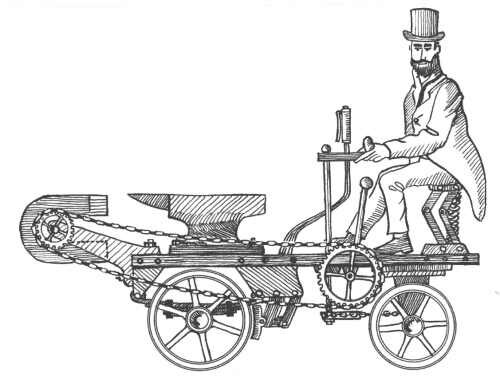 |
| Hans-Peter Gramatke's magnet-mobile. The magnet pulls the iron anvil. Note the brake lever that rotates the horseshoe magnet to stop the vehicle. |
|---|
 |
| Simanek's silly spring device. |
|---|
References:
At these two sites you can find pictures of many perpetual motion devices you might want to build yourself. They are guaranteed to be unworkable.
Donald Simanek's Museum of Unworkable Devices,
http://www.lhup.edu/~dsimanek/museum/unwork.htm .
Hans-Peter Gramatke's Pages, http://www.hp-gramatke.net/index.htm .
Picture captions and links to highest resolution picture files. Use these rather than the pictures in the text above.
Left click to view, then download. Or right click and you use "save target as" to save to a storage location. You will probably want to reduce the size of these, especially the line drawings.
One of Bhaskara's wheels. baskara1.gif [Get permission from hans-Peter Gramatke
Villard de Honnecourt's wheel. honnecor.jpg
Wooden model of Villard's wheel built by Hans-Peter Gramatke. villard01.jpg
Model of Villard's wheel. villard1.tif
[Optional close-up picture of construction set model of Villard's wheel.] Construction details of model of Villard's wheel. villard2.gif
The action of the flipping weight. honecor2.gif
Simon Stevin's ball-ramp. stevin.gif
Model of Stevin's chain. stevinmod1.tif
Pierre Richard's Overbalanced chain (B), with brake (C). 1858. British patent No. 1870.
brake-pm.gif
Arthur E. Gilbert's perpetual motion, 1902, with a helpful arrow. gilbert.gif
Woodward's wheel. woodward2.tif
Hans-Peter Gramatke's magnet-mobile. The magnet pulls the iron anvil. Note the brake lever that rotates the horseshoe magnet to stop the vehicle.
magnet_car1.jpg [Get permission from hans-Peter Gramatke
Simanek's silly spring device. sssd-hp1.gif [Get permission from hans-Peter Gramatke
